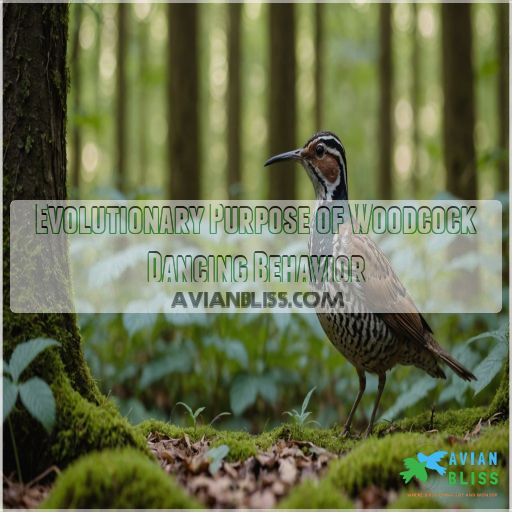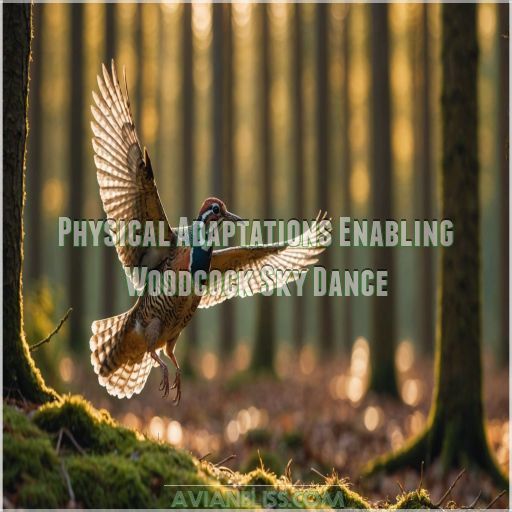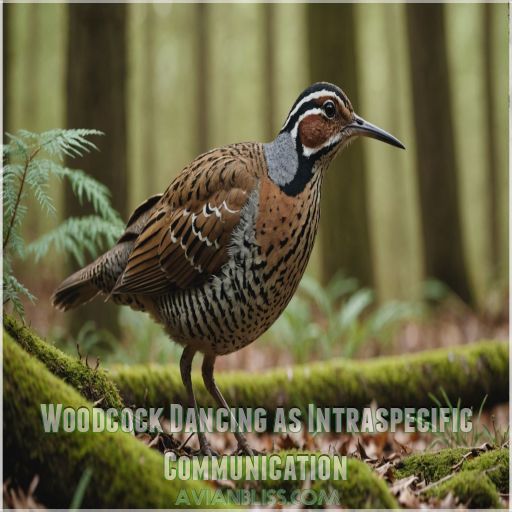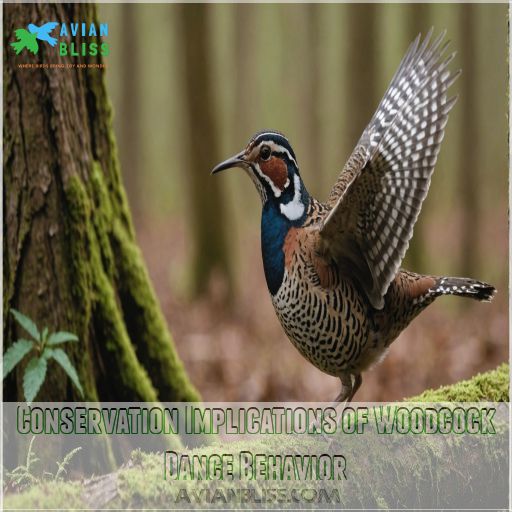This site is supported by our readers. We may earn a commission, at no cost to you, if you purchase through links.

These peculiar ground-dwellers perform an elaborate sky dance for several reasons. They’re trying to woo potential mates, showing off their fitness and genetic quality. It’s like nature’s version of a dating app profile, but with more flair!
The dance also helps establish territory, sending a clear "keep out" message to rival males. Plus, it’s a way to communicate important information within their species.
Their unique rocking motion while walking isn’t part of the dance, but it might help disturb tasty earthworms. Who knew these quirky birds had such method to their method to their madness? They also have a dating app profile.
Table Of Contents
- Key Takeaways
- The Woodcock’s Unique Sky Dance Ritual
- Evolutionary Purpose of Woodcock Dancing Behavior
- Acoustic Elements of the Woodcock Dance
- Physical Adaptations Enabling Woodcock Sky Dance
- Environmental Factors Influencing Woodcock Dancing
- Woodcock Dancing as Intraspecific Communication
- Conservation Implications of Woodcock Dance Behavior
- Frequently Asked Questions (FAQs)
- What is a woodcock Bird’s Dance?
- Why do woodcocks dance?
- How do woodcocks perform a’sky dance’?
- What does a woodcock dance sound like?
- What is a woodcock sky dance?
- Why do woodcocks walk this way?
- What is the woodcock dance?
- Why do the birds do these dances?
- What kind of bird dances while it walks?
- What is special about a woodcock?
- Do woodcock perform courtship displays outside breeding season?
- How do woodcock detect earthworms while dancing?
- What habitats do wintering woodcock prefer?
- How do conservation efforts maintain woodcock dance grounds?
- Do female woodcock participate in courtship dances?
- Conclusion
Key Takeaways
- You’ll be amazed to learn that the woodcock’s sky dance isn’t just a quirky habit—it’s a multifaceted courtship display ritual that helps these birds attract mates, establish territories, and showcase their fitness
. It’s like nature’s version of a dating app profile, but with more aerial acrobatics.
- As you watch a woodcock perform, you’re witnessing a complex form of avian communication. Their peent calls, wing twittering, and elaborate flight patterns are all carefully choreographed to convey specific messages to potential mates and rival males. It’s like they’re speaking a secret language written in the sky.
- You might think these birds are just winging it, but their dance is actually the result of some impressive physical adaptations. From specialized wing structures to enhanced night vision, woodcocks are built for their twilight performances. They’re like the avian world’s answer to ballet dancers—graceful, precise, and perfectly tuned to their art.
- Next time you’re out at dusk, keep your eyes peeled for this feathered Fred Astaire. The woodcock’s dance isn’t just entertaining—it’s a crucial behavior for their survival and a key indicator of ecosystem health. By preserving their habitats, you’re not just saving a dance, you’re helping keep the rhythm of nature alive.
The Woodcock’s Unique Sky Dance Ritual
You’re about to witness one of nature’s most amazing performances: the American Woodcock’s sky dance.
This unique mating ritual, featuring elaborate acrobatics and musical sounds, will leave you amazed and wanting to learn more about these quirky birds.
Peenting Calls on the Ground
As dusk falls, you’ll hear the woodcock’s peculiar serenade begin.
These feathered Casanovas kick off their sky tango with a ground-based overture: the infamous peent call. Picture a nasal buzzer going off every few seconds – that’s our lovestruck woodcock for you!
This bizarre peenting isn’t just random noise; it’s a carefully crafted come-hither call to potential mates . Talk about setting the mood!
Spiraling Ascent With Musical Twittering
From the ground, you’ll hear a sudden change in the woodcock’s performance. The bird takes flight, soaring upward in wide spirals.
As it ascends, its wings produce a musical twittering sound that intensifies with height.
This aerial acrobatics showcases the woodcock’s unique wing structure and feather mechanics, designed for both flight and sound production.
It’s like watching a tiny fighter jet perform a sky tango, all in the name of love!
Tumbling Descent With Soft Warbling
After reaching the apex of its spiral flight, you’ll witness the woodcock’s grand finale.
As it tumbles earthward, the bird serenades you with a soft, dolphin-like warble.
This smoochy sound adds a touch of romance to the sky dance. Scientists are still debating whether it’s produced by feathers, vocal cords, or a combination of both.
It’s nature’s way of saying, "Hey there, good-looking!
Return to Original Location
You’ve witnessed the woodcock’s aerial acrobatics, but here’s the kicker: these feathered navigators return to their exact starting point . It’s like they’ve got a built-in GPS!
This homing instinct isn’t just for show – it’s a key part of their mating ritual.
By consistently returning to the same spot, male woodcocks establish their territory and increase their chances of catching a female’s eye.
Talk about dancing with a purpose!
Duration and Timing of the Dance
Now that you’ve witnessed the woodcock’s return, let’s talk timing. These sky tangos aren’t all-night affairs. Typically, the show lasts about 30 minutes, kicking off 15-20 minutes after sunset.
But on bright moonlit nights, these feathered Freds might keep the dance floor hopping all night long.
Peak season varies by region, with southern states peaking in early April and northern areas hitting their stride in May, which is a great time to see the sky tangos.
Evolutionary Purpose of Woodcock Dancing Behavior
You’ve seen the woodcock’s mesmerizing sky dance, but have you ever wondered why these quirky birds put on such an elaborate show?
Let’s uncover the evolutionary secrets behind this avian tango and discover how it helps woodcocks survive and thrive in the wild, where birds ditched teeth
.
Attracting Potential Mates
The woodcock’s sky dance isn’t just a quirky habit – it’s a full-blown courtship spectacular!
Male woodcocks pull out all the stops to woo potential mates with their aerial acrobatics. Imagine this: as dusk falls, these feathered Romeos take center stage, hoping to catch a lady’s eye (Source).
Their performance includes:
- Heart-pounding peent calls that’ll make you swoon
- Dizzying spiral flights reaching 300 feet high
- A dramatic, warbling descent that’s music to a female’s ears
Establishing and Defending Territory
Ever watched a woodcock defend its turf? It’s like a feathered bouncer at nature’s nightclub!
These quirky birds take their real estate seriously, using their sky dance to lay claim to prime nesting spots.
When rival males encroach, the territorial calls ramp up – you’ll hear a fierce "cac-cac-cac-cac" as the defender zooms in the direction of the intruder [4).
It’s a high-stakes game of aerial chicken in the woodcock world!
Demonstrating Physical Fitness and Genetic Quality
You’ve got to hand it to those woodcocks – their sky dance isn’t just for show!
By performing elaborate aerial acrobatics, these birds are flexing their avian muscles, so to speak.
The dance’s energetic cost and required flight agility serve as health indicators, showcasing a male’s physical fitness and genetic quality to potential mates.
It’s like nature’s version of a fitness competition, where the most impressive dancers often enjoy greater mating success.
Facilitating Species Recognition
In the face of nature’s complexity, woodcocks have mastered the art of species recognition through their sky dance.
You might wonder how these quirky birds make sure they’re not mating with the wrong species.
Their unique dance serves as a visual and auditory ID card, helping them:
- Stand out in a crowd of feathered friends
- Avoid awkward inter-species dating mishaps
- Showcase their "woodcock-ness" with flair
This avian tango isn’t just for show—it’s a key part of their evolutionary strategy.
Enhancing Reproductive Success
The woodcock’s sky dance isn’t just a pretty show – it’s a reproductive powerhouse. By putting on this aerial spectacle, male woodcocks are flexing their genetic muscles.
Let’s break down how this dance boosts their baby-making success:
| Dance Feature | Reproductive Benefit |
|---|---|
| Fancy Flight | Proves stamina & health |
| Loud Peents | Attracts distant females |
| Melodic Warbles | Seals the deal up close |
| Dance Ground Fidelity | Increases mating chances |
This feathered tango translates directly into more chicks and a thriving woodcock population.
Acoustic Elements of the Woodcock Dance
You’re about to discover the symphony of sounds that make up the woodcock’s sky dance.
From ground-based peents to wing-produced twitters, each acoustic element plays a key role in this avian aerial ballet.
Ground-based Peent Calls
Let’s tune in to the woodcock’s ground-based peent calls, the opening act of their sky tango. These nasal, buzzy sounds are like nature’s doorbell, announcing the start of something spectacular.
You’ll hear them:
- Just before dawn or after sunset
- Repeated every few seconds
- For about 1-2 minutes before takeoff
These peents aren’t just random noise – they’re a carefully crafted invitation to potential mates and a warning to rival males. Talk about setting the stage for romance!
Soft Tuko Sounds Before Peenting
You’ve heard the peent, but did you know there’s a prelude? Before belting out their famous call, woodcocks whisper a soft "tuko" sound. It’s like they’re clearing their throats for the main event! This subtle vocalization adds another layer to their acoustic repertoire.
| Tuko Sound | Characteristics |
|---|---|
| Volume | Soft, whisper-like |
| Timing | Just before peenting |
| Function | Possibly warming up |
| Detection | Often overlooked |
These gentle tuko sounds might serve as a warm-up or a secret code between woodcocks. Either way, it’s another quirky detail in their sky tango!
Wing-produced Twittering During Ascent
As the woodcock spirals skyward, you’ll hear a mesmerizing twittering sound.
This isn’t the bird’s voice – it’s all in the wings! The secret lies in the woodcock’s unique feather structure.
Three narrow outer primaries vibrate as air rushes through them, creating a whistling symphony.
- Feather adaptation: Specialized wing structure for sound production
- Airflow magic: Rushing air creates vibrations between feathers
- Continuous performance: Twittering lasts throughout the 20-second ascent
- Nature’s instrument: Wings act like tiny flutes in flight
Vocal or Feather-generated Descent Sounds
The mystery of the woodcock’s descent sounds has puzzled ornithologists for years. As you listen to their sky dance, you’ll hear intriguing chirps during the bird’s dramatic swoop. But are these vocal or feather-generated?
Some bird species, such as vultures, use thermal soaring tactics to conserve energy, but the woodcock’s unique aerial display relies on different techniques. The woodcock’s nocturnal displays may be influenced by the same principles that guide starlings’ mesmerizing murmurations, where the collective flight produces a low murmuring sound.
| Sound Type | Evidence For | Evidence Against |
|---|---|---|
| Vocal | Chirp-like quality | Never overlaps twittering |
| Wing-generated | Coincides with movements | Difficult to observe |
| Feather-adapted | Narrow outer primaries | Inconclusive studies |
| Combined | Complex sound production | Lack of definitive proof |
While conventional wisdom leans vocal sounds, recent research suggests these chirps might be produced by specially adapted wing feathers.
Significance of Acoustic Variations
Ever wondered why woodcock calls sound so different? It’s not just for show! These acoustic variations play a key role in their sky dance.
- Acoustic camouflage: Helps them blend in with natural sounds
- Sound localization: Allows other woodcocks to pinpoint their location
- Species identification: Helps them attract the right dance partner
By tweaking their calls, woodcocks can effectively communicate their fitness, territory, and readiness to mate . It’s like their own unique DJ mix – each bird spinning a slightly different tune!
Physical Adaptations Enabling Woodcock Sky Dance
You’re about to discover the fascinating physical adaptations that make the woodcock’s sky dance possible.
These unique features, from specialized wing structures to enhanced visual systems, work together to create one of nature’s most mesmerizing aerial performances.
Wing Structure for Aerial Maneuvers
You’ve heard the woodcock’s sky dance, but have you ever wondered how these birds pull off such amazing aerial feats? It’s all in the wings! Woodcocks have evolved specialized wing structures that allow them to perform their intricate courtship displays with grace and precision.
Let’s take a closer look at the wing features that make these birds the Fred Astaire of the avian world, particularly their unique visual abilities, such as tetrachromatic eyes, which allow them to perceive a diverse range of colors in their vibrant avian world:
| Wing Feature | Function | Dance Move |
|---|---|---|
| Pointed tips | Improved maneuverability | Quick turns |
| Broad base | Increased lift | Spiraling ascent |
| Slotted primaries | Reduced air resistance | Silent flight |
| Flexible feathers | Enhanced control | Tumbling descent |
| Compact shape | Efficient power | Rapid wingbeats |
These adaptations allow woodcocks to execute their sky dance with finesse, impressing potential mates and leaving birdwatchers in awe.
While nightjars have evolved for slower, more buoyant flight, woodcocks have perfected the art of aerial acrobatics.
Vocal Apparatus for Unique Calls
Chirps, peents, and twitters – the woodcock’s vocal repertoire is as unique as its dance moves.
You’ll be amazed by how evolution has fine-tuned this bird’s sound-producing equipment. Its specialized vocal apparatus allows it to create a range of distinctive calls, from the nasal, buzzing "peent" to the soft "tuko".
These vocalizations play a key role in the woodcock’s courtship display, helping it attract mates and defend territory.
Visual System for Low-light Performance
The woodcock’s visual system is a marvel of low-light adaptation. You’d be amazed at how these birds navigate the twilight world.
Their eyes, set far back on their heads, give them an incredible field of vision . Here are three key features of their night-vision superpowers:
- Densely packed retinal rods
- Large, light-gathering pupils
- Specialized cells for detecting magnetic fields
These adaptations allow woodcocks to spot predators and forage effectively in near-darkness, turning them into nocturnal ninjas of the forest floor.
Muscular Endurance for Repeated Flights
Let’s spread our wings and explore the woodcock’s impressive flight muscles!
These little birds are built for endurance, performing their sky dance night after night during mating season . You’d think they’d tire out, but woodcocks have evolved specialized muscles that can handle repeated takeoffs and landings.
Their flight patterns demand quick bursts of energy, so their bodies have adapted to efficiently store and use fuel for these nightly aerial marathons.
Sensory Adaptations for Spatial Awareness
Woodcocks aren’t just muscular marvels; they’re sensory superstars too!
You’d be amazed at their spatial awareness adaptations:
- 360-degree vision for all-around predator detection
- Eyes set far back on their heads for an alien-like look
- Binocular vision bands in front and back
- Highly sensitive bill for detecting earthworms
These features give woodcocks their "sixth sense" in the sky. It’s like they’ve got built-in radar, making their aerial dance a breeze. Talk about dancing with your eyes in the back of your head!
Environmental Factors Influencing Woodcock Dancing
You might think woodcocks dance just for fun, but there’s more to their sky tango than meets the eye.
They have a specific environment that plays a key role in shaping this avian ballet.
From the perfect dance floor to the ideal mood lighting, let’s explore how the environment influences their behavior.
Habitat Requirements for Dance Grounds
You’ve got to hand it to these feathered Casanovas – they’re picky about their dance floors.
Woodcocks seek out young forests or shrubby old fields with just the right mix of open space and cover . They’re like nature’s real estate agents, scouting for moist soil to probe for worms and enough room to strut their stuff.
It’s all about location, location, location for these sky-dancing divas, making them particularly finicky about their surroundings, much like nature’s real estate agents.
Seasonal Timing of Dance Displays
Have you ever wondered when the woodcock’s sky tango takes center stage? These feathered performers don’t just dance on a whim. Their seasonal displays are a carefully choreographed affair, typically occurring in spring and summer .
- Breeding readiness
- Geographic location
- Local climate patterns
As the earth warms, we’re seeing shifts in peak display dates, with some birds starting their aerial ballet earlier than usual. It’s nature’s own climate change canary!
Impact of Weather Conditions
During the woodcock’s spring sky dance, weather conditions play a big role in setting the stage for this avian tango. You’ll find these birds aren’t fair-weather performers – they’re ready to strut their stuff in various conditions.
Let’s break down how different weather elements impact the woodcock’s dance:
| Weather Element | Impact on Dance | Woodcock Response |
|---|---|---|
| Wind Speed | Affects flight | Adjusts ascent |
| Rainfall | Dampens ground | Seeks drier spots |
| Temperature | Influences energy | Adapts display duration |
| Cloud Cover | Alters visibility | Modifies timing |
| Snow | Limits food access | Delays dancing |
Moonlight Effects on Dance Duration
So another thing is to keep in mind.
There aren’t that many bird species that have to be considered, and how these species are affected by weather conditions, but that’s the possible cue to find the bird.
I mean, it isn’t to move to the next region, or to keep them in their current habitat, that they can hunt woodcock, that they can hunt woodcock, or that they can hunt woodcock, in order to find the possible cue to locate the bird in their current habitat.
Anthropogenic Influences on Dance Habitats
Moonlight’s magic on woodcock dances fades as human activities reshape their stages. You’d be surprised how our actions impact these feathered performers’ habitats.
- Habitat loss from urban sprawl
- Forest management altering singing grounds
- Light pollution disrupting natural rhythms
- Noise pollution drowning out peents
It’s like we’re accidentally rewriting the woodcock’s dance script. But don’t worry, with a bit of awareness, we can help keep their sky tango alive and kicking!
Woodcock Dancing as Intraspecific Communication
You might think woodcocks are just doing a funky dance for fun, but there’s a lot more to their sky tango than meets the eye.
These feathered performers are actually engaged in a complex form of bird-to-bird communication, sharing key information with potential mates and rivals alike.
Male-to-Female Signaling
Imagine a moonlit ballroom where the male woodcock takes center stage, performing his sky tango to woo the ladies. You’d be amazed at how these little birds use their aerial acrobatics as a language of love.
Their dance variations aren’t just for show – they’re sending intricate mating cues to potential partners.
| Signal Type | Message | Female Response |
|---|---|---|
| Peent calls | "I’m here!" | Approaches singing ground |
| Sky dance | "Check out my moves!" | Assesses male fitness |
| Wing twittering | "Listen to my song!" | Evaluates acoustic quality |
These courtship rituals are nature’s version of a dating app, helping females select their ideal mate.
Male-to-Male Competition
While woodcocks dazzle the ladies, they’re also sizing up the competition.
These feathered Casanovas aren’t just putting on a show for potential mates – they’re sending a clear message to rival males: "This is my turf, buddy!"
Their sky dance serves as a dominance display, establishing territorial boundaries through acoustic signaling.
It’s like a high-stakes game of aerial chicken, where the most impressive dancer gets the prime real estate.
Information Conveyed Through Dance Variations
Have you ever wondered what secrets lie hidden in the woodcock’s sky dance?
As these quirky birds twirl and tumble, they’re not just showing off – they’re sending coded messages. Their dance variations convey a wealth of information, from male-to-male signals to mate quality cues.
The complexity of their aerial acrobatics serves as a fitness indicator, while the duration and intensity of their performance might just reveal how much territory they’re claiming.
Role in Pair Formation
Diving into the woodcock’s sky tango reveals its important role in pair formation. You’ll see how these feathered Romeos use their aerial ballet to win the hearts of potential mates.
The dance serves as a multifaceted courtship ritual:
- Advertising availability
- Demonstrating physical fitness
- Showcasing genetic quality
- Establishing territory
As males strut their stuff, females play the role of discerning critics, evaluating each performance to choose their ideal partner . It’s nature’s version of "Dancing with the Stars"!
Influence on Breeding Success
You’ve seen how the woodcock’s sky dance helps form pairs, but let’s look at how it impacts their breeding success. Imagine you’re a female woodcock watching this aerial tango – it’s not just for show! The dance’s quality can influence your mate choice, which in turn affects your nesting and chicks’ survival.
Check out this breakdown:
| Dance Feature | Mate Quality | Breeding Impact |
|---|---|---|
| Flight height | Stamina | Healthier chicks |
| Peent volume | Strength | Better nest defense |
| Dance duration | Dedication | More attentive parent |
Woodcocks that nail their sky dance are more likely to attract mates and produce successful broods . It’s nature’s way of ensuring the best genes get passed on – talk about high-stakes dancing!
Conservation Implications of Woodcock Dance Behavior
You might think the woodcock’s quirky sky dance is just for show, but it’s a key behavior that’s under threat.
As we explore the conservation implications of this aerial tango are explored, you’ll discover how habitat loss, climate change, and human disturbance are putting the woodcock’s elaborate courtship ritual at risk.
Habitat Loss and Fragmentation Effects
The woodcock’s sky tango faces a formidable foe: habitat loss and fragmentation.
As forests shrink and fragment, these aerial dancers find their ballrooms dwindling. Edge effects creep in, disrupting the delicate balance of their performance spaces.
You’ll notice fewer woodcocks twirling in the twilight as species decline follows suit.
But don’t lose hope! By preserving habitat connectivity, we can keep the dance floor open for these feathered Fred Astaires, allowing them to continue their aerial dancers performance.
Climate Change Impacts on Dance Timing
As the Earth’s climate shifts, so does the woodcock’s sky tango schedule.
You might notice these quirky birds adjusting their dance cards to sync with earlier springs. Their breeding season’s getting a makeover, with warmer temperatures playing matchmaker earlier in the year.
This climate-induced time warp isn’t just about fashionably early arrivals – it’s reshaping entire ecosystems and potentially throwing the woodcock’s delicate mating rituals out of step with their food sources.
Human Disturbance to Dance Grounds
Many woodcock dance grounds face increasing human disturbance.
You’ll find these birds performing their sky dance in open fields with scrubby edges (Source), but urban sprawl and recreational activities can disrupt their natural rhythms.
Light pollution may confuse their twilight displays, while noise pollution drowns out their distinctive "peent" calls. As you explore nature, remember: your presence might inadvertently crash their celestial tango party.
Let’s tread lightly to keep the dance floor open!
Importance for Population Monitoring
Three key reasons make woodcock dance behavior important for population monitoring.
You’ll find it’s a reliable indicator of habitat quality and breeding success.
By tracking dance frequency and duration, researchers can gauge survival rates and population trends (Source).
It’s like nature’s own census system. As habitat changes occur, these sky tangos serve as an early warning system, helping conservationists stay one step ahead in protecting these quirky performers.
Dance Preservation in Conservation Strategies
You’ve got to hand it to the woodcock – its sky dance is more than just a quirky mating ritual. It’s a key part of conservation efforts.
To preserve this avian tango, we need to:
- Restore and protect suitable habitats
- Monitor population trends through dance surveys
- Minimize human disturbance to dance grounds
- Promote sustainable wildlife tourism
By safeguarding these feathered Fred Astaires, we’re not just preserving a dance – we’re keeping the rhythm of nature alive!
Frequently Asked Questions (FAQs)
What is a woodcock Bird’s Dance?
Picture a bird performing an airborne ballet at twilight.
You’re witnessing the woodcock’s mesmerizing courtship dance.
It’s a quirky ritual where males take flight, spiraling skyward while emitting distinctive calls and whistles, all to woo potential mates.
Why do woodcocks dance?
Woodcocks dance to woo their mates in an impressive aerial display.
You’ll see males peenting on the ground, then launching skyward with whistling wings, performing acrobatic descents.
It’s their way of showing off and attracting females.
How do woodcocks perform a’sky dance’?
It’s a jaw-dropping spectacle!
You’ll witness male woodcocks launch skyward at twilight, spiraling up to 300 feet while twittering.
They’ll then plummet dramatically, warbling as they descend, before landing right where they started.
It’s nature’s ultimate aerial show!
What does a woodcock dance sound like?
You’ll hear a nasal "peent" sound as the male starts his dance on the ground.
Then, as he takes flight, listen for rapid twittering from his wings, followed by smoochy, dolphin-like calls during his descent.
What is a woodcock sky dance?
The sky dance is a mesmerizing courtship ritual performed by male woodcocks at twilight.
You’ll witness them spiraling up to 300 feet high, then descending in a zigzag pattern while making unique sounds to attract mates.
Why do woodcocks walk this way?
Woodcocks walk with a peculiar rocking motion to help them detect prey.
You’ll see them keeping their heads steady while their bodies sway, possibly applying pressure to the ground to make earthworms and insects move.
It’s quite the dance!
What is the woodcock dance?
Witness a mesmerizing courtship ritual as male woodcocks take center stage.
They’ll strut their stuff with nasal "peent" calls, then rocket skyward in spiraling flight, whistling with their wings before dramatically plummeting back to earth.
It’s nature’s own aerial ballet!
Why do the birds do these dances?
Observe, marvel, and ponder: woodcocks dance for love and survival.
They rock to detect prey, woo mates with sky-high performances, and even fake injuries to protect chicks.
It’s nature’s quirky choreography in action!
What kind of bird dances while it walks?
You’ll be fascinated by the American woodcock’s unique strut.
These quirky birds rock their bodies back and forth while keeping their heads perfectly steady as they walk.
It’s like they’re grooving to their own internal beat!
What is special about a woodcock?
Woodcocks are nature’s quirky performers.
They’ve got eyes on the back of their heads, a wacky rocking walk, and a sky dance that’ll knock your socks off.
Plus, they’re master actors in protecting their chicks.
Do woodcock perform courtship displays outside breeding season?
While woodcocks primarily strut their stuff during breeding season, you might catch a glimpse of their sky dance as early as December in southern regions.
It’s like they’re practicing their moves year-round, just in case!
How do woodcock detect earthworms while dancing?
Imagine being so desperate for a meal, you’d dance like nobody’s watching!
Woodcocks rock their bodies and step heavily, causing worms to move in the soil.
Their flexible bill tips then detect and capture the unsuspecting prey.
What habitats do wintering woodcock prefer?
You’ll find wintering woodcock cozying up in young forests and shrublands .
They’re partial to damp soil where earthworms abound, like alder flats, abandoned fields, and recently logged areas.
At night, they roost in weedy fields for protection.
How do conservation efforts maintain woodcock dance grounds?
Conservation efforts go above and beyond to maintain woodcock dance grounds.
You’ll find dedicated teams clearing old fields, managing young forests, and preserving seeping slopes.
They’re creating a grand stage for nature’s quirkiest performers to strut their stuff.
Do female woodcock participate in courtship dances?
Female woodcocks don’t participate in the famous sky dance. They’re the audience, watching males perform their acrobatic displays.
While guys peent and spiral through the air, gals play hard to get, waiting to be impressed by the males’ efforts, specifically when they.
Conclusion
Who knew birds could be such skilled dancers?
Now you understand why woodcock birds dance – it’s not just for fun! These feathered performers are nature’s ultimate multitaskers, using their sky tango to woo mates, claim territory, and show off their fitness.
Next time you spot a woodcock’s quirky waddle or hear its peent call, you’ll know there’s more to the story. So, keep your eyes on the skies – you might just catch a glimpse of this avian ballroom in action!










